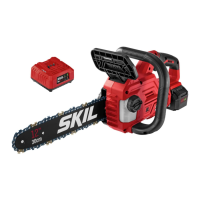
Do you have a question about the Skil PWRCORE 20 CS4562B-00 and is the answer not in the manual?
| Type | Chainsaw |
|---|---|
| Battery Voltage | 20V |
| Bar Length | 12 inches |
| Chain Pitch | 3/8 inches |
| Chain Gauge | 0.05 inches |
| Oil Tank Capacity | 200 mL |
| Power Source | Battery |
Keep work area clean, well lit, avoid hazards. Match plugs, avoid water, use GFCI.
Stay alert, use PPE, prevent unintentional starting, remove keys, do not overreach.
Use correct tool, repair if faulty, disconnect power for adjustments, care for batteries.
Keep body parts away from chain, use correct hand placement, maintain footing.
Wear PPE, avoid unstable supports, be alert for spring back.
Carry saw safely, use only for wood, understand felling risks.
Kickback from misuse; avoid by proper grip, technique, and chain maintenance.
The chain brake stops the chain during kickback; test before use.
Use certified low-kickback chains and recommended guide bars for safety.
Use two hands, ensure clear area, maintain footing, avoid obstructions.
Avoid contact with sharp parts, do not operate damaged tools.
Avoid abusive cutting, use guide bar correctly, plan felling and escape routes.
Avoid charging in wet areas, do not incinerate, do not expose to heat.
Understand DANGER, WARNING, CAUTION for hazard severity.
Messages to prevent equipment or property damage if instructions are not followed.
Understand symbols for volts, amperes, watts, speed, temperature, and ingress protection.
Understand symbols for battery capacity, Li-ion RBRC seal, and recycling.
Symbols for not exposing to rain and mandatory protective gear like goggles and gloves.
Symbols for two-handed hold and guide bar tip kickback warnings.
Symbols from UL, CSA, Intertek, and NOM indicating product compliance.
Identifies handles, trigger, lock-off button, and brake handle.
Identifies guide bar, chain, oil tank, sheath, and storage rail.
Details model, voltage, bar length, chain pitch/gauge, speed, and capacity.
Lists recommended Model Numbers for Guide Bar (SBR1200) and Saw Chain (SCN1200).
Use for felling, limbing, pruning; lists compatible battery packs and chargers.
Steps to safely attach and detach the battery pack.
Instructions for filling the oil tank before use.
Checks for chain tension, oil level, and brake function before starting.
Step-by-step guide to start the chain saw safely.
How to stop the saw, engage brake, and general handling safety.
Work area safety, proper stance, and correct hand grip for control.
Recommendations for initial practice and basic cutting with two hands.
Warnings for felling in hazardous conditions and preparing safe retreat paths.
Steps for making the notch and felling back cut to control tree fall direction.
Removing branches from a fallen tree, cutting tensioned limbs safely.
Cutting techniques for logs supported along their entire length or on one end.
General cleaning and steps to disassemble the worn bar and chain.
Safety warnings and detailed steps for replacing the guide bar and saw chain.
Steps for looping chain, mounting to saw, and ensuring correct orientation.
How to check and adjust chain tension for optimal performance and safety.
Use low-kickback chains, maintain sharpness for efficient cutting and reduced wear.
Steps for filing cutters to specified angles and length using a file and holder.
CORRECT 30°, LESS THAN 30°, MORE THAN 30° angles for cutter top plates.
CORRECT 60°, HOOK, BACKWARD SLOPE angles for cutter side plates.
Maintaining depth gauge clearance at 0.025 in. (0.6 mm) for safe cutting.
Reversing bar, cleaning rails, and lubricating sprocket for longevity.
Steps to remove, flip, and reassemble the guide bar for even wear.
Guidelines for securely transporting and storing the chain saw and accessories.
Causes and remedies for motor not running or chain not rotating.
Causes and remedies for chain brake issues and poor cutting.
Causes and remedies for bar and chain running hot and smoking.
Details warranty period, registration, exclusions, and remedies for SKIL tools.
